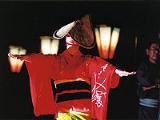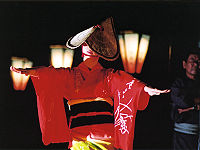
Kaze no bon
Encyclopedia

Japanese festivals
Japanese festivals are traditional festive occasions. Some festivals have their roots in Chinese festivals but have undergone dramatic changes as they mixed with local customs....
held every year from September 1 to 3 in Yatsuo
Yatsuo, Toyama
was a town located in Nei District, Toyama, Japan. It is famous for Owara Kaze no bon festival.On April 1, 2005 Yatsuo, along with the towns of Ōsawano and Ōyama, both from Kaminiikawa District, the town of Fuchū, and the villages of Hosoiri and Yamada, all from Nei District, was merged into the...
, Toyama
Toyama Prefecture
is a prefecture of Japan located in the Hokuriku region on Honshū island. The capital is the city of Toyama.Toyama is the leading industrial prefecture on the Japan Sea coast, and has the industrial advantage of cheap electricity due to abundant water resources....
, Japan
Japan
Japan is an island nation in East Asia. Located in the Pacific Ocean, it lies to the east of the Sea of Japan, China, North Korea, South Korea and Russia, stretching from the Sea of Okhotsk in the north to the East China Sea and Taiwan in the south...
. Kaze-no-Bon literally translates to "Bon Dance of the Wind."
This festival, having a history of about 300 years, is recently becoming a popular tourist attraction to the otherwise sparsely populated mountain area. The original festival was held in order to appease typhoons and allow for a bountiful harvest of rice.
What makes this festival so unique is that it is held at night. The streets are decorated with paper lanterns, and long rows of young men and women, their faces covered by low-brimmed straw hats, dance simultaneously to rather melancholic music. This particular style of music is also unique to the region, using an otherwise rare instrument, the kokyu
Kokyu
The is a traditional Japanese string instrument, the only one played with a bow. Although it was introduced to Japan from China along with the shamisen, its material, shape, and sound are unique to Japan...
(胡弓). A well-aged female voice and a traditional shamisen
Shamisen
The , also called is a three-stringed, Japanese musical instrument played with a plectrum called a bachi. The Japanese pronunciation is usually "shamisen" but sometimes "jamisen" when used as a suffix . -Construction:The shamisen is a plucked stringed instrument...
(三味線) often accompanies the kokyu.
The hats, worn with matching kimonos, cover the dancers faces to hide them from the wrath of the god they hope to appease. One other feature of the dancers is that they are all unmarried. This is similar to the idea that 1) doing the dance may gain the attention of the gods who may get mad at them and 2) to do the dance is akin to a virginal self-sacrifice. But these far more traditional ideas that are carried by superstition. Aversely. some say that the dancers, young and unmarried, do the dance to show off and meet other young unmarried people.
The traditional, old-fashioned, shop-lined sloping streets and winding staircases of the small town make the festival quite spectacular, and the dark atmosphere of the festival is often described as rather "creepy" to many people who have experienced it.
Aside from the dance, games, trinkets and other traditional foods and services are also offered from the tiny shops lining the streets. Special Japanese paper is a popular souvenir for visitors to this festival.

